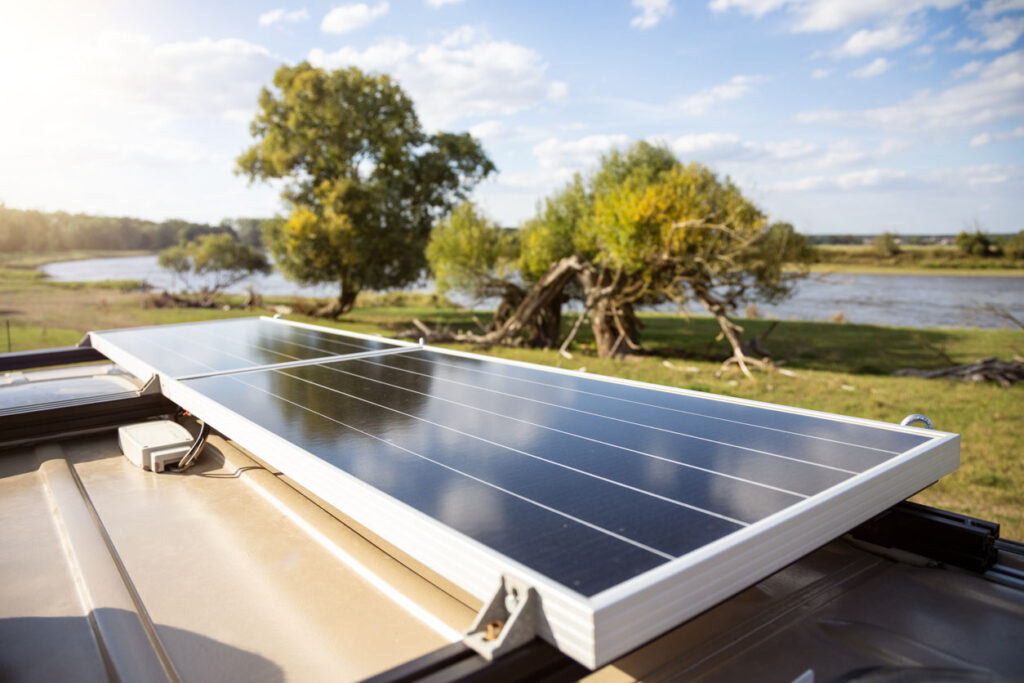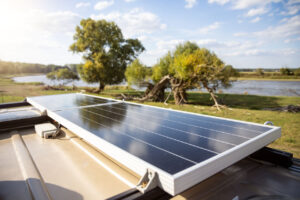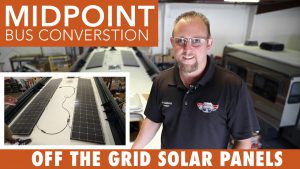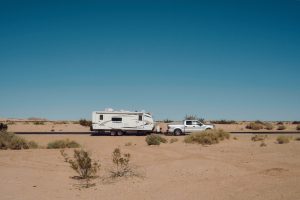The sun-soaked dream of cruising down open roads, kitchen foraging with wild greens, and relaxing evenings with the stars as your ceiling—RV travel ignites a sense of freedom and adventure. Yet, a growing number of RVers are seeking additional independence from conventional diesel generators and campsites hardwired with electricity.
This surge in self-sufficiency comes with an increased interest in solar power. By harnessing the sun’s energy, RVers can tap into an affordable and eco-friendly way to power their motorhomes. If you’re an eco-conscious traveler, an RV enthusiast, or simply yearning for off-grid living, you’ve arrived at the proper roadmap to solar transformation.
Is An RV Solar System Right for You?
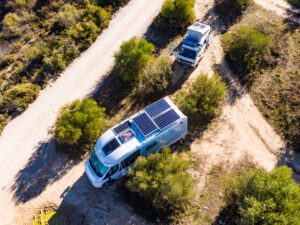
Before you hoist panels on your rig, it’s vital to weigh the sunlit benefits against the potential shadows. An RV solar system is a robust investment of time and money. Consider your typical travel patterns. Are you often on the move or stay stationary for extended periods?
Solar power is perfect for those who appreciate long boondocking stints—camping without hookups in nature’s pristine outback. By contrast, RVers who prefer the structured luxuries of full-service campsites may not see a return on their solar investment.
Knowing how much power you need is critical.
Is your RV equipped with multiple appliances, such as a microwave, refrigerator, and air conditioner? You’ll need more solar power output than an RVer primarily using their rig for sleeping and light cooking.
In short, you should do a little research before making the switch to solar power. Evaluate your travel habits and energy needs before diving in.
How Do RV Solar Panels Work?
In essence, RV solar panels harness sunlight and convert it into electricity. This electricity is used directly to power your RV’s devices or stored in batteries for later use. The process is surprisingly simple, yet the choice and setup of your solar rig can be as complex as the most intricate backcountry trails. Here are the essential components of an RV solar system:
- Solar Panels: These panels, also known as photovoltaic (PV) modules, capture sunlight and convert it into direct current (DC) electricity.
- Charge Controller: This device regulates the flow of electricity from your panels to your batteries, preventing overcharging and damage.
- Batteries: Your solar energy is stored in batteries for later use, similar to a backup generator.
- Inverter: This component converts the DC electricity stored in your batteries into alternating current (AC), which runs your RV’s devices.
How Many Solar Panels Does Your RV Need?
The number of solar panels you’ll require depends on several factors, such as the size and type of panels, your RV’s power needs, and the average sun hours per day in your intended travel regions. As a rough guide, a 100-watt solar panel generates approximately 30 amp-hours (Ah) of electricity a day. But do the math with your specific situation in mind—every rig is a unique, power-hungry beast.
Types of Solar Panels
Monocrystalline, Polycrystalline, or Thin—solar panels come in various flavors, each with its own advantages and costs:
- Monocrystalline: These panels are the most efficient and longest-lasting option made from a single, high-grade silicon crystal. They’re also the most expensive.
- Polycrystalline: These panels are made by melting raw silicon into molds, making them more affordable than monocrystalline. However, their efficiency is slightly lower.
- Thin-Film: These flexible and lightweight panels are perfect for unconventional RV shapes or limited roof space. However, they’re less efficient and require more extensive installations.
Choosing the correct type of panel for your rig depends on your specific needs and budget. It’s crucial to do your research and consult with experts before making a decision.
Assessing Your RV’s Solar Needs
To ensure your battery is well-juiced and life on the road remains comfortably powered, you must accurately compute your RV’s solar necessities. Measurement in kilowatt-hours (kWh) is a good starting point, but translate this into daily and seasonal watts to properly size your solar system.
Determining Power Requirements
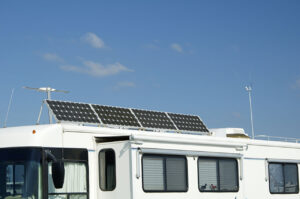
List every electrical device you intend to use, accounting for wattage and average daily usage. Don’t forget the phantom power thieves—appliances that draw energy even when not in use. By conducting an energy audit of your RV, you’ll be able to discern the total daily load your solar setup must support.
Gauging Battery Capacity
Understanding your battery’s capacity and needs is crucial. Different battery types, such as flooded lead-acid or lithium-ion, have different voltage and storage capacities. Research the required charging patterns for your specific battery type to maximize its lifespan.
It’s also essential to keep in mind that solar panels may not produce enough power during cloudy days, so having a backup generator or the ability to plug into shore power may still be necessary for extended stays off-grid.
Compute Solar Panel Energy Production and Storage Requirements
Once you have your total average daily usage, allow for a buffer in case the sun isn’t shining as brightly as expected. Consider seasonal variations. More sun in the summer could provide energy for air conditioning, but shorter and cloudier winter days require a backup plan or beefier panel setup. An intelligent charge controller and efficient battery bank ensure no Watt is wasted.
RV Size and Class
There are three classes of RVs: A, B, and C. Class A is the most significant and luxurious, while Class B is the smallest. Each class has different size constraints for solar panel installation. For example, a Class B camper van likely won’t have enough roof space for more than one or two panels, whereas a large Class A motorhome may have ample room on its roof for multiple panels.
Installation Process
Installing an RV solar system may seem daunting, but it can be straightforward with the right tools and knowledge. Here are the basic steps involved:
- Determine where to place your panels: Ideally, you’ll want to install them on your RV’s roof for maximum sunlight exposure.
- Install mounting brackets: These will secure your panels to your RV’s roof.
- Wire your panels together: Connect the panels in a series to increase voltage or parallel for increased amperage.
- Install a charge controller: This will regulate the flow of electricity from your panels to your batteries.
- Connect your panels to your battery bank: Use proper wiring and connectors, following all safety precautions.
- Install an inverter (if necessary): This step is only required if you plan on using AC devices in your RV.
- Test and monitor: Make sure everything is working correctly and monitor your system’s performance regularly.
Consulting with a professional or following detailed installation instructions specific to your solar setup can also ensure a successful installation process.
Mounting Solar Panels
When it comes to mounting your panels, there are several options available, including:
- Fixed Mounts: These are the most popular and secure option for RVs. They are permanently attached to the roof.
- Tilting Mounts: These allow you to adjust your panels’ angle manually, optimizing sun exposure.
- Portable Mounts: Perfect for those who want flexibility in panel placement, these mounts can be placed on the ground or other surfaces.
Always make sure to carefully follow installation instructions and use proper safety precautions when installing your solar panels.
Connecting the System to Your RV’s Electrical System
Wiring the solar panels through a charge controller, then to your battery bank, and finally to the inverter that converts stored DC power to AC for your appliances is a spaghetti of cables. Attention here is paramount—overcurrent can lead to fried circuits and, in an extreme case, conflagration. Waterproof and UV-resistant cables are also worth the investment to protect against the elements.
Optimizing Solar Power Usage
Even with the mightiest solar array, conserving energy remains critical. Replacing your incandescent bulbs with LED lighting, installing energy-efficient appliances, and developing a frugal energy-use mindset are all part of the sun-powered lifestyle. Power monitoring devices can also help you track and reduce unnecessary energy consumption.
Energy-Efficient Appliances
Replacing older models with Energy Star-rated, RV-specific, solar-friendly counterparts can significantly impact the appliance fleet. Once you are aware of the wattage per hour of each device, it’s easier to manage your power output and consumption.
Battery Storage and Maintenance Tips
The Achilles heel of solar systems—batteries are crucial yet temperamental creatures.
Routine maintenance is essential whether you opt for lead-acid, AGM, or lithium.
Keeping them clean, well-ventilated, and correctly charged can significantly extend their life and your solar system’s usefulness. Additionally, implementing a battery monitoring system can help you keep track of your battery’s health and performance over time.
Cost Considerations
While the long-term benefits of solar power are numerous, the initial setup can be a weighty endeavor. Budgeting for the conversion is a must, considering the cost of solar panels, other hardware, potential professional installation, and any subsequent running repairs or upgrades.
Budgeting for Solar Conversion
Shop around for the best deals on solar panels, aiming for the highest quality within your budget. Don’t forget to include the costs for ancillary equipment like mounting, wiring, charge controllers, and inverters. You may also need additional or updated batteries suited for your new solar system.
Potential Savings in The Long Run
Savings from not having to pay for campsites with hookups or fuel for a generator are just the beginning. Long-term financial gains stem from the ability to prolong battery life, reduce maintenance costs, and the satisfaction of using a renewable energy source that doesn’t contribute to climate change.
Benefits of Solar Power for RVs
Sustainability isn’t just about the numbers—it’s a lifestyle. Converting your RV to solar power ensures you leave the smallest carbon wheel-trace on your adventures. Solar energy also gives you an unmatched sense of freedom and self-reliance, fostering a closer connection to nature and the landscapes you roam.
Environmental Impact
Each kilowatt-hour generated from solar instead of traditional fuels adds green miles to your RV’s odometer. The carbon emissions saved can be significant, especially for full-time RVers, making solar an integral part of the eco-travel movement.
Independence from Traditional Power Sources
There’s something deeply satisfying about knowing the power humming in your RV comes directly from the sun—that golden orb is your power company for all practical purposes. Solar also means no more scouting for electrical hookups or the dance to conserve generator fuel.
Join the Solar-Powered RV Revolution
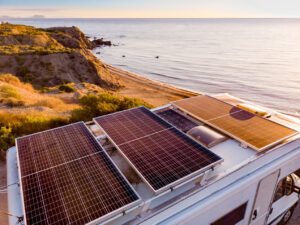
The switch to solar power may seem like a steep curve in the RV lifestyle, but it’s a trajectory bursting with light. It’s about refining your travel priorities, minimizing impact, and maximizing your freedom. As technology advances, so does the feasibility of solar power for RVs. It’s more accessible and robust than ever, beckoning to be a permanent fixture on the RV enthusiast’s to-do list. Solar power might be the jolt your RV adventures need to evolve into truly sustainable, off-the-grid experiences.
